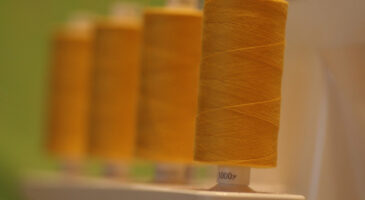Are you a silk lover? If indeed you are, you should have heard about Shantung fabric; if you haven’t, you should consider getting this fabric on your next shopping trip.
This fabric is not ordinary silk but the gold version of this famous natural fiber fabric.

Just like silk, Shantung fabric is also known for its fantastic properties like high absorbency level, breathability, smoothness, and shininess.
The only slight difference is that these properties are abundant in the case of Shantung, which is why you will see them mainly used for high-end wedding gowns.
I can’t say much about the fabric here, but if you want to know more about what shantung fabric is or what it is made of, jump straight into the body of this article.
What are Shantung fabrics?
Shantung is a silk fabric type characterized by its irregular ridges, commonly called slubs.
This natural fabric is made with top-quality silk threads, giving the material its unique silky texture whenever touched.
Just like the traditional silk fabric, Shantung fabric is also considered a luxury fabric and is known for its lightness, crispness, and excellent draping quality.
Shantung fabric history
The production of Shantung fabric started in the Shandong province of China. Although there are several accounts of when this fabric was first woven, there is substantial evidence of when the material initially reached the western population: a period between 1300 to 1700.
This fabric, Shantung, was named after the province it originated from, but it remains somewhat unclear whether or not it was the Chinese or the western culture that named the fabric.
In the early times of this fabric, because silk fabrics with smoother weaves were quite popular among the people of western culture, it didn’t receive widespread acceptance until more recently when people started to recognize the unique texture and appearance of the fabric.
How is Shantung fabric made?
Manufacturers will first have to harvest silkworm cocoon fibers from the mulberry tree, which are usually cultivated to make Shantung fabrics.
Then proceeded to boil them to slacken their fiber.
Afterward, the fiber will be placed in an industrial machine to brush the cocoon to find the loose ends (this can also be done manually by hand).
Afterward, the fiber will be loaded into a reel through an eyelet by an industrial machine or a factory worker.
The cocoon will start to unravel once the reel starts to spin, and each cocoon fiber will be attached to the next to create a continuous string. This will continue until the continuous string reaches the desired length when a worker turns them into yarn by twisting the strings together.
After this stage, silk production can be done in two ways, leading to two separate silk yarns.
The first one requires that the yarn is placed in a roller which gives it a uniform appearance.
The second type does not involve the use of a roller, and this type is called slub yarn. This type of yarn has irregular nubs on its surface.
The weft of Shantung fabric is made from regular uniform silk yarn, and slub yarn is used for the warp. Once producers weave these two yarns together, it will produce a nubby or slightly irregular fabric with a uniform appearance.
In the last stage, Shantung fabric is dyed mainly before they are woven into garments and sometimes may be treated with chemicals to enhance its fire resistance quality.
Where is Shantung fabric made?
Shantung is made in China, the province of Shandong.
What are the different types of Shantung fabric?
Dupioni
Dupioni is an Italian silk fabric very similar to Shantung but with different slubs making the material more irregular in appearance.
Compared to Shantung, Dupioni is also thicker but will have less draping quality.
Silk Shantung
This original Shantung fabric is made from silk and is considered the most expensive of all three types. Despite that, it remains the most popular Shantung thanks to its unusual appearance.
Synthetic Shantung
Although this Shantung type is very scarce, you can still find Shantung made with synthetic material that will mimic the exact texture and appearance of Shantung fabric.
What is Shantung fabric used for?
Shantung is used majorly for making fashion items and is popularly used in making blouses, tailored pants, dresses, evening wears, men’s shirts, wedding gowns, ladies’ dresses, and vests.
Can you wash Shantung silk?
No, you can’t wash your Shantung silk.
The best way to clean your Shantung silk is by dry cleaning them because you may damage your garment when you wash them either in the machine or with your hand.
If you want to wash your shantung silk in the machine, use a mesh bag to prevent your garment from tangling.
How do you care for Shantung fabric?
You can spot-clean your Shantung fabric, either upholstery shampoo, mild detergent, or mild solvent.
When using any of these cleaners, do this in a well-ventilated area and follow the instructions carefully.
Also, avoid using toxic material or any product that has carbon tetrachloride.
Is Shantung silk real silk?
Yes, Shantung is real silk. Original Shantung silk is made from the materials used in making other silk types, a protein fiber produced from silkworms.
Is Shantung a polyester?
No, Shantung is not polyester. Yes, we have some Shantung types that are made of polyester, but these types are very scarce due to the complexity of their production.



